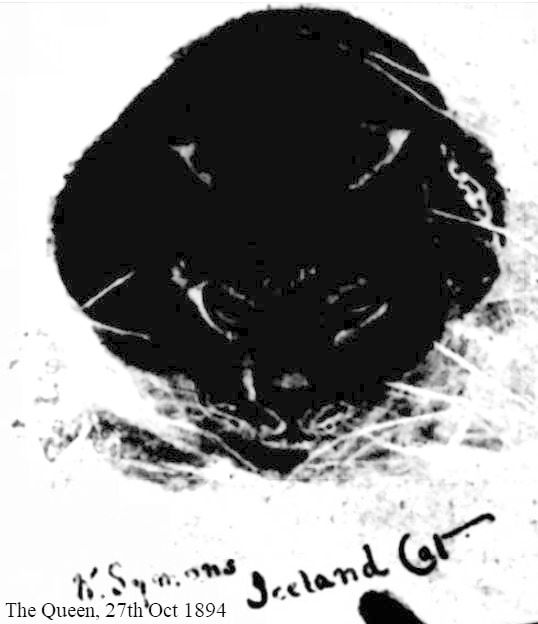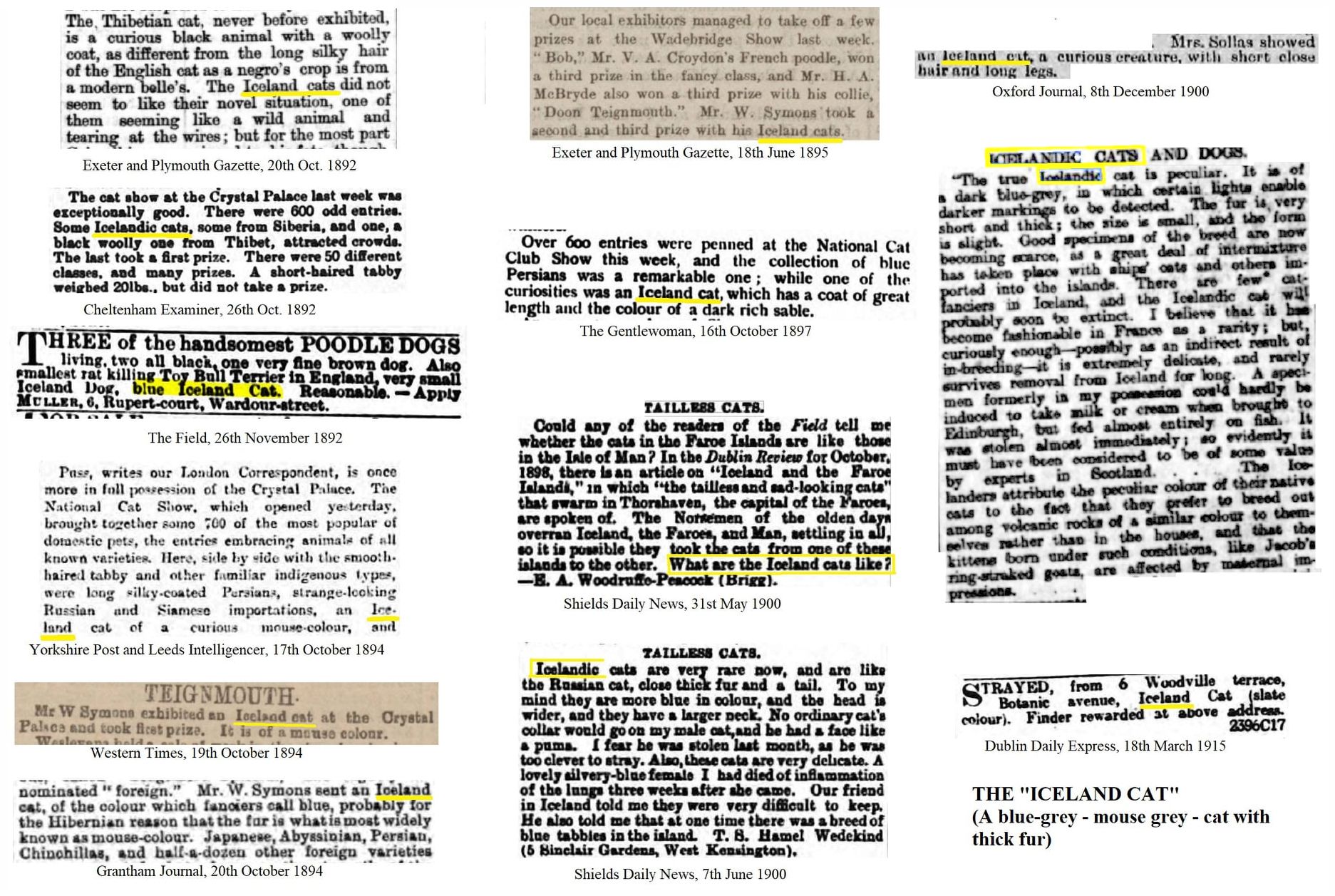
LOST BREEDS - ICELAND CAT
The Iceland Cat was a breed exhibited in the 1890, but which had vanished by the early 1900s. Most reports trace back to Mr Symons who exhibited his Iceland cats at Crystal Palace and at local shows over several years. In 1892 they were wide reported, but there was a year’s gap before the breed was again reported at the show, again exhibited by Mr Symons. There was no information about the number of cats he had (most reports mention 2 cats) nor whether they reproduced.

“Perhaps the most interesting of the exhibits to those who have no particular "fancy” for any special variety of the feline race are those from Iceland, Siberia, and Thibet, but which are more curious than beautiful. “ (The National Cat Show. Morning Post, 19th October 1892)
“Besides the usual varieties of cats at the show there are one or two “novelties” — a cat from Tibet, the first ever exhibited here, and two kittens from a farm in Iceland. “(Cat Show At The Crystal Palace. The Times, October 19, 1892.)
“Among the cats were several brought from an Icelandic farm three days' journey inland from Reykjavik.” (The National Cat Show. London Evening Standard, 19th October 1892)
“The Iceland cats did not seem to like their novel situation, one of them seeming like a wild animal and tearing at the wires.”(Cat Show at the Crystal Palace. Exeter and Plymouth Gazette, 20th October 1892)
“. . . two piquant kittens from a farm in Iceland.” (Crystal Palace Cat Show. London Evening Standard, 20th October 1892)
“Cats also came from Archangel, from Siberia, and from the interior of Iceland, but there was nothing very remarkable about them.” (National Cat Show. Preston Herald, 22nd October 1892)
“A pair of blues from Iceland gained a second prize.” (National Cat Show. The Sportsman, 19th October, 1892.)
“. . . an Iceland cat of a curious mouse-colour . . .” (Crystal Palace Cat Show. Yorkshire Post and Leeds Intelligencer, 17th October 1894)
“The visitor from Iceland, another blue, or rather cinder-coloured animal, also refused to show his points.” (Cats at the Crystal Palace. London Daily News, 17th October 1894)
“Mr. W. Symons sent an Iceland cat, of the colour which fanciers call blue, probably for the Hibernian reason that the fur is what is most widely known as mouse-colour. “ (Annual Exhibition of the National Cat Club. London Evening Standard, 17th October 1894)
“In the latter class a very fine Iceland cat, Quita, appears in our sketches.” (The Crystal Palace Cat Show. The Queen, 27th October 1894) Unfortunately the sketch of a cat’s head is too dark and indistinct to give any further idea about the breed.
“A two days' bazaar and cat show was concluded Friday evening in Teignmouth Temperance Hall . . .The prizes for cats were taken by Mr W Symons for Iceland breed.” (Cat Show. Western Times, 21st May 1895)
The report of 1895 is the last I can find referring to Mr Symons’ cats. Perhaps he no longer wanted to travel the distance to London to exhibit them, or perhaps they had died of one of the infectious diseases that spread in cat shows of that time.
There are actually some tantalising hints at similar blue-grey cats from Iceland and Norway that slightly pre-date Mr Symons’ Iceland cats. Mrs Carew-Cox, an early breeder of Russian Blues, had noted that short-haired blues existed in the north of Norway, Iceland and some parts of the US. "Many years ago, some blues (with faint tabby markings) were imported from the north of Norway; these were called 'Canon Girdlestone's breed'. I owned two very pretty soft-looking creatures." and also "In 1890 I owned a very pretty soft-looking blue female - she was, in fact, a blue tabby (one of Canon Girdlestone's breed); also a male of the same variety.” Unfortunately, both cats had been heavily infested with tapeworms when she got them and both died. A few years earlier there is this snippet: "The fifteenth National Cat Show at the Crystal Palace presented an interesting collection of feline pets. [...] Mrs. Carl Brook exhibited two pure-bred Norwegian kittens, bluish-black in colour, three months old — 'Punch and Judy' by name." (The East & South Devon Advertiser, 20th October 1883).
The next report of an Iceland cat seems to be a very different type as it was not slate-grey but a dark brown colour: “one of the curiosities was an Iceland cat, which has a coat of great length and the colour of a dark rich sable.” (Crystal Palace Cat Show. Gentlewoman, 16th October 1897) This seems to be a bit of an anomaly, as later reports mention the blue-grey cats.
In 1900, the Iceland cat was mentioned as an aside in a query to the “Field” (a hunting and field-sports journal) and the question and its response were reproduced in the Shields Daily News. Although the original question was about tailless cats, the response came from an owner of an Iceland cat, showing that Mr Symons was not the only person to have this breed. Unfortunately the female had died shortly after importation and the male had been stolen.
“Could any of the readers of the ‘Field’ tell me whether the cats in the Faroe Islands are like those in the Isle of Man? In the Dublin Review for October, 1898, there is an article on “Iceland and the Faroe Islands,” in which “the tailless and sad-looking cats" that swarm in Thorshaven, the capital of the Faroes, are spoken of. The Norsemen of the olden days overran Iceland, the Faroes, and Man, settling in all, so is it possible they took the cats from one of these islands to the other. What are the Iceland cats like?” - B. A. Woodruffe-Peacock (Brigg). (Shields Daily News, 31st May 1900)
“Icelandic cats are very rare now, and are like the Russian cat, close thick fur and a tail. To mind they are more blue in colour, and the head wider, and they have a larger neck. No ordinary cat's collar would go on my male cat, and he had a face like a puma. I fear he was stolen last month, as he was too clever to stray. Also, these cats are very delicate. A lovely silvery-blue female I had died of inflammation of the lungs three weeks after she came. Our friend in Iceland told they were very difficult to keep. He also told me that at one time there was breed of blue tabbies in the island. T. S. Hamel Wedekind, 5 Sinclair Gardena, West Kensington.” (Shields Daily News, 7th June 1900)
This seemed to rekindle the interest in the cats. At that time, hunters often donated interesting specimens to natural history societies or captured live specimens for collections, so the following might have been triggered by the correspondence in the “Field.”: “A very interesting meeting for the exhibition of animals and plants by the members of the Natural History Society was held on Thursday evening . . . Mrs Sollas showed an Iceland cat, a curious creature, with short close hair and long legs . . . we would have liked to see more of Mrs. Sollas' Iceland cat.” (Oxford Journal, 8th December 1900)
Perhaps the most comprehensive description of the Iceland cat come from “The Faroes and Iceland: Studies in Island Life” by Nelson Annandale, published by Henry Frowde. This excerpt was reprinted in the Leicester Daily Post, 4th July 1905:
"The true Icelandic cat is peculiar. It is of a dark blue-grey, in which certain lights enable darker markings to be detected. The fur is very short and thick; the size is small, and the form slight. Good specimens of the breed are now becoming scarce, as a great deal of intermixture has taken place with ships’ cats and others imported into the islands. There are few cat-fanciers in Iceland, and the Icelandic cat will soon be extinct. I believe that it has become fashionable in France as a rarity; but, curiously enough – possibly as an indirect result of in-breeding - it is extremely delicate, and rarely survives removal from Iceland for long. A specimen formerly in my possession could hardly be induced to take milk or cream when brought to Edinburgh, but fed almost entirely on fish. It was stolen almost immediately; so evidently it must have been considered of some value by experts in Scotland. The Icelanders attribute the peculiar colour of their native cats to the fact that they prefer to breed out among volcanic rocks of a similar colour to themselves rather than in the house, and that the kittens born under such conditions, like Jacob’s ring-streaked goats, are affected by maternal impressions.”
